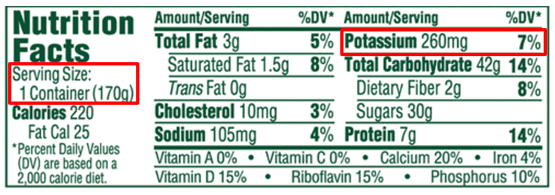Low Potassium Diet
Why does my child need a low potassium diet?
Potassium is a nutrient found in food. It helps the body keep a regular heartbeat, contract muscles and control blood pressure.
In kidney disease, and some other medical conditions, potassium levels build up in the blood. High potassium levels may cause heart and muscle problems. A low potassium diet may help avoid these problems.
High potassium food list
May only choose up to 2 servings of a high potassium food per day
| Fruits: |
|
|
Vegetables: |
|
|
Other Foods: |
|
|
Combination foods: |
|
|
Dairy Products: You may have plain or vanilla rice milk (do not use soy, almond or coconut milk.) Non-dairy creamer can be used to replace milk on cereal. |
|
These foods may be eaten as desired. If you have any questions about a food that is not listed please contact your dietitian.
| Fruits: |
|
|
Vegetables: |
|
|
Other foods: |
|
|
Combo foods: |
|
Nutrition Facts labels
- Nutrition Facts labels must list the amount of potassium in a packaged food. The amount will be listed in milligrams (mg) and also as a percent (%).
- When reading the Nutrition Facts label, always look at the serving size. Many foods have more than 1 serving.
- When eating more than 1 serving you will get more potassium.
- Limiting high potassium foods to two servings a day works well for most people.
- If you want to count total potassium from all foods, talk to your dietitian for the right amount. It is specific for each child.
- When potassium is only listed as a percent on the food label, follow this info. It will help you know if a food is high or low in potassium.
- Low potassium foods have 0 to 5% potassium per serving.
- High potassium foods have 6% or more potassium per serving.
- On this food label, this food has 7% potassium per 1 serving. It is a high potassium food.

Tips
- Do not use salt substitutes with potassium chloride. This includes NoSalt™, NuSalt™ or Lite Salt™. Use herbs and spices like Mrs. Dash®, garlic, or lemon juice as seasoning.
- Do not use sports drinks or Coconut Waters. They contain more added potassium and sodium than other beverages.
- Root vegetables, such as potatoes, that are high potassium can be “leached.” Peel the potatoes and cut in small pieces. Soak in a large pan of water for several hours. Pour off the water and then cook as normal.
- Use trusted websites when looking for renal diet information. We recommend:
o http://www.Kidney.org
o http://www.Davita.com



